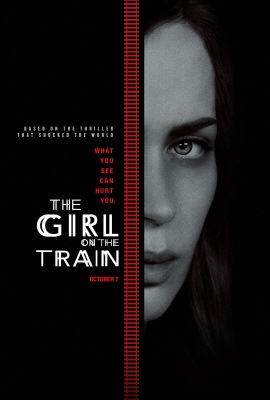 Keeping the hook of the book intact, the film version of “The Girl on the Train” zips along nicely and makes Emily Blunt an acting force to be reckoned with.
Keeping the hook of the book intact, the film version of “The Girl on the Train” zips along nicely and makes Emily Blunt an acting force to be reckoned with.
If you’ve read the book, you’ll know “The Girl on the Train” is a mystery told from the viewpoints of three women, though mainly through its title character Rachel (Blunt), a woman on a commuter train who is fixated on a particular house along her route. In this house lives Megan (Haley Bennett), a beautiful young woman who is often seen by Rachel lounging on her deck or in the arms of her husband, Scott (Luke Evans). To Rachel, Megan lives the idyllic life- one that Rachel longs for. We soon learn that Rachel used to live in a house near Megan’s, that Rachel’s own marriage dissolved after her inability to have children led to her becoming an alcoholic, and that Rachel’s husband Tom (Justin Theroux) left her for Anna (Rebecca Ferguson), whom he was having an affair with while married to Rachel.
Rachel, painfully watching Megan’s seemingly perfect life through the train window while sipping away her sorrows through a vodka-filled water bottle, sees something disturbing one day: Megan on her deck in the arms of another man. Knowing the pain of adultery and angered that Megan is going to ruin the life she envies, Rachel’s alcohol-fueled rage makes her leave the train to confront Megan. This all ends badly when Rachel stumbles from the train and gets an opportune chance to encounter Megan, who’s out for her daily run. After calling out for Megan, Rachel boozily blacks out and awakes the next day at home, bloodied and bruised. Without remembering what happened, Rachel’s even more confused when she learns that Megan has gone missing. Is Rachel responsible?
Of course, there’s a lot more melodrama and interpersonal connections involved in the central mystery of “The Girl on the Train” to allow every character in the story to become a “red herring” and culpable suspect in the disappearance of Megan. In spite of the book’s soap opera structure that allows the viewpoints of Megan and Anna to add fuel to the fire, the fun of the book was seeing Rachel become a besotted sleuth- can she find out what happened to Megan and clear her name of any involvement she may or may not have had?
The film handles its subplots well, but knows its strength lies in its ladies. With Haley Bennett (“The Magnificent Seven”) as Megan and Rebecca Ferguson (“Mission Impossible: Rogue Nation”) as Anna, each actress has a knack for showcasing their characters’ strengths and internal struggles. Using screenwriter Erin Cressida Wilson to delve into these female characters (as she had writing “Chloe” and “Secretary”) and choosing director Tate Taylor to juggle the women’s stories as well as he did in “The Help” are also smart moves. But it’s Emily Blunt who really impresses as Rachel by giving a raw and emotional performance.
Playing an alcoholic in the midst of a melodrama can’t be easy, but Blunt manages to use a controlled skill to keep Rachel from becoming “over-the-top.” In tearful outbursts that tap into all the pain and anger her character endures, Blunt conveys heartache and loss with a pathos that never panders. Just watching the scene where Rachel visits Megan’s therapist to try to uncover clues and, under the guise of a new patient, quickly succumbs to the therapy and breaks down are enough to make Blunt an Oscar contender. If playing a character with a disease or handicap gets the Academy’s attention, playing an alcoholic well is pure Oscar bait- Blunt plays an alcoholic well.
While a film version of a bestselling novel like “The Girl on the Train” may seem ripe for derailment, the talent involved keeps its story on track.
